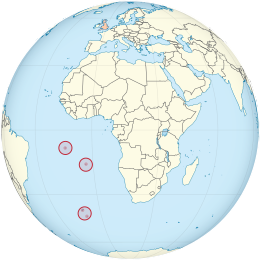Commons:Copyright rules by territory/Saint Helena, Ascension and Tristan da Cunha
|
Copyright rules: Saint Helena, Ascension and Tristan da Cunha Shortcut: COM:SAINT HELENA, ASCENSION AND TRISTAN DA CUNHA | |
 | |
 | |
| Durations | |
|---|---|
| Standard | Life + 50 years |
| Photograph | Publish + 50 years |
| Anonymous | Publish + 50 years |
| Posthumous | Publish + 50 years |
| Other | |
| Terms run to year end | Yes |
| Common licence tags | {{PD-old-auto}} |
| ISO 3166-1 alpha-3 | SHN |
| Treaties | |
| Berne convention | 5 December 1887 |
| Univ. Copyright Convention | 27 September 1957 |
| WTO member | 1 January 1995 |
| URAA restoration date* | 1 January 1996 |
| WIPO treaty | 14 March 2010 |
| *A work is usually protected in the US if it is a type of work copyrightable in the US, published after 31 December 1928 and protected in the country of origin on the URAA date. | |
This page provides an overview of copyright rules of the Saint Helena, Ascension and Tristan da Cunha relevant to uploading works into Wikimedia Commons. Note that any work originating in Saint Helena, Ascension and Tristan da Cunha must be in the public domain, or available under a free license, in both Saint Helena and the United States before it can be uploaded to Wikimedia Commons. If there is any doubt about the copyright status of a work from Saint Helena, refer to the relevant laws for clarification.
Background[edit]
Saint Helena, Ascension and Tristan da Cunha is a British Overseas Territory in the South Atlantic. It consists of Saint Helena, Ascension Island and the archipelago of Tristan da Cunha. Saint Helena has a Governor and a Legislative Council, whilst Tristan da Cunha and Ascension each have an Administrator and an Island Council.
The United Kingdom Copyright Act 1956 applied to overseas territories, including Saint Helena, except for ss. 32, 34, 35, 42 & 44 and Schedules 4 & 5, as defined by the Copyright (St Helena) Order 1963 (SI 1963/1038). The United Kingdom's Copyright (Computer Software) Amendment Act 1985 except ss. 4(3), & 5 did not apply to St Helena.[1] The World Intellectual Property Organization (WIPO), an agency of the United Nations, holds the text of the Copyright Act 1956 in their WIPO Lex database.[2]
General rules[edit]
Under the Copyright Act 1956,
- Copyright subsisting in a work ... shall continue to subsist until the end of the period of 50 years from the end of the calendar year in which the author died, and shall then expire.[1956 Sec.2(3), 3(4)]
- If the work had not been made public before the death of the author, copyright shall continue to subsist until the end of the period of 50 years from the end of the calendar year which it was made public.[1956 Sec.2(3), 3(4)]
- Where the first publication of a literary, dramatic, or musical work. or of an artistic work other than a photograph, is anonymous or pseudonymous, any copyright subsisting in the work ... shall continue to subsist until the end of the period of 50 years from the end of the calendar year in which the work was first published, and shall then expire.[1956 2nd Sched. Sec.2]
- The copyright in a photograph shall continue to subsist until the end of the period of 50 years from the end of the calendar year in which the photograph is first published, and shall then expire.[1956 Sec.3(4b)]
Freedom of panorama[edit]
![]() OK for works of architecture, sculptures, and artistic craftsmanship. Freedom of panorama is provided by Sections 9(3) and 9(4) of the Copyright Act 1956. For other types of works (like street art),
OK for works of architecture, sculptures, and artistic craftsmanship. Freedom of panorama is provided by Sections 9(3) and 9(4) of the Copyright Act 1956. For other types of works (like street art), ![]() Not OK. Per Section 9(5), unspecified artistic works can only be included in broadcasts or films in an incidental manner, or at background (de minimis valid for audio-visual media only).
Not OK. Per Section 9(5), unspecified artistic works can only be included in broadcasts or films in an incidental manner, or at background (de minimis valid for audio-visual media only).
The FoP legal rights are identical to British overseas territories still using the 1956 copyright law (like the British Virgin Islands and the Falkland Islands), all are modelled upon the British version, see also Commons:Copyright rules by territory/United Kingdom#Freedom of panorama.
See also[edit]
- Saint Helena, Ascension and Tristan da Cunha
- Commons:Copyright rules by territory/British Overseas Territories
- Commons:Copyright rules by territory/United Kingdom
Citations[edit]
- ↑ List of UK laws applied to St Helena, Ascension and Tristan da Cunha: Revised Edition 2017. Saint Helena Government. Retrieved on 2019-03-11.
- ↑ Copyright Act, 1956 4 & 5 ELIZ. 2 CH. 74. United Kingdom.